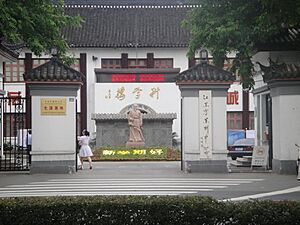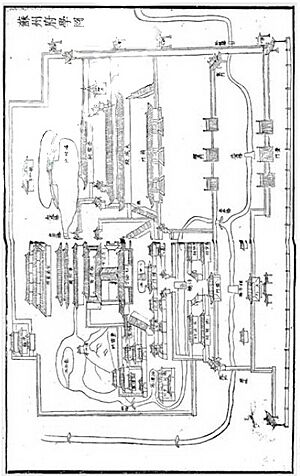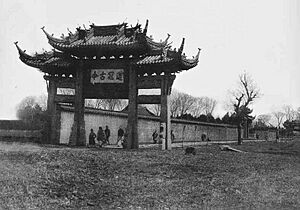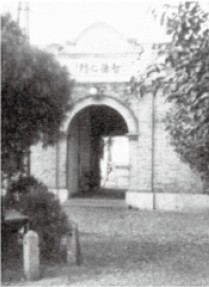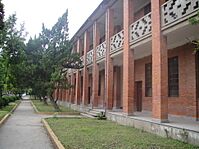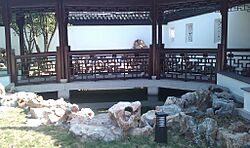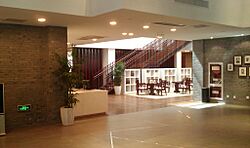Suzhou High School of Jiangsu Province facts for kids
The Suzhou High School of Jiangsu Province is a famous public high school in Suzhou, Jiangsu, China. It is one of the oldest schools in China, with a history stretching back almost 1,000 years!
The school started in 1035. A famous leader named Fan Zhongyan founded its first version, the Suzhou Prefecture School. Over the centuries, it grew and changed, becoming a very important place for learning. Many smart people, including famous scholars and scientists, have studied or taught here. Today, it is known as one of the best high schools in the Jiangnan region of China.
In 1953, the school was chosen as one of China's top 24 high schools. It was also named one of the top four high schools in Jiangsu Province. In 2004, it became a "four-starred" high school, which is a high honor. Many students from Suzhou High School go on to study at top universities around the world.
Contents
A Long History of Learning
The First School: Suzhou Prefecture School
The story of Suzhou High School began in 1035. This was when Fan Zhongyan, a prime minister during the Northern Song dynasty, started the Suzhou Prefecture School. This was a very new idea at the time. It was the first time a government-supported school was combined with a Confucian temple.
Fan Zhongyan even gave his own house to help build the school. He wanted to create a place where students could learn from the best teachers. This marked the beginning of Suzhou High School's long and rich history.
Ziyang College and New Ideas
Later, during the Qing dynasty, a college called Ziyang College was set up inside the Suzhou Prefecture School. Most government schools at that time focused on preparing students for official exams. However, Ziyang College focused on Neo-Confucianism, which was a deeper study of ancient Chinese philosophy.
Famous teachers from all over China came to teach here. This made the college very popular with students. Sadly, in 1860, the school was badly damaged during the Taiping Rebellion. But it was rebuilt 14 years later, showing how important it was.
Becoming a Modern School
In the early 1900s, China's old examination system changed. So, in 1904, the school became a modern school called Jiangsu Normal School. The governor of Jiangsu, Duanfang, invited very famous scholars like Luo Zhenyu and Wang Guowei to teach there. This helped the school become a leading public high school.
In 1911, the school changed its name to Jiangsu Provincial No.1 Normal School. Students from the school were very active in important events, like the May Fourth Movement. They even helped influence government decisions!
In 1927, a new principal, Wang Maozu, who had studied at Harvard University, took over. He invited more famous scholars, including Qian Mu and Zhang Taiyan, to teach. In 1932, the school started admitting girls, which was a big step forward for education in China.
During World War II, the Japanese Army occupied Suzhou in 1937. The school had to move many times to stay safe and keep teaching. It moved to different cities and even changed its name to avoid attention. Finally, in 1945, after the war ended, Suzhou High School returned to its original campus.
Suzhou High School Today
Since 1978, Suzhou High School has continued to be a top school. It was one of the first schools to be named a key secondary school again.
In 1985, the school started special classes with the University of Science and Technology. These classes helped students prepare for college.
The school also works with many schools and universities around the world. It has partnerships in Japan, Singapore, the United Kingdom, the United States, Canada, Australia, and New Zealand. In 2007, Suzhou High School even started a special program called the Cambridge International High School program.
Suzhou High School has also helped start other schools. The Suzhou Lida Middle School was founded in 1996. In 2003, the Suzhou High School Park affiliate was opened in Suzhou Industrial Park.
Amazing Teachers
Suzhou High School has many highly qualified teachers. This includes five professors for senior secondary school and 19 top-grade teachers in the province. They work hard to help students learn and grow.
School Campus
The school is located on Renmin Road in Suzhou. It covers a large area, about 160 mu, which is like 106,667 square meters!
The main teaching buildings are around Daoshan Hill. The Science Building, which faces the main gate, is a symbol of the school. There are also East and West Red Buildings and East and West White Buildings. The school also has a library, a laboratory building, an info-tech building, and a stadium, all built in the 1990s.
Famous People Who Studied Here
Many students from Suzhou High School have become very famous in different fields.
Scientists
- Tsung-Dao Lee: A physicist who won the Nobel Prize.
- Chien-Shiung Wu: An experimental physicist who won the Wolf Prize.
- Xiaowei Zhuang: A biophysicist.
Engineers
- Yuan-Cheng Fung: A bioengineer.
- Chia-Shun Yih: A fluid mechanics engineer.
Politicians
- Qin Bangxian: An early leader of the Communist Party of China.
- Zhou Yongkang: A former party and state leader.
Writers
- Lu Wenfu
Entrepreneurs
- Yu Liang: The president of China Vanke Co., a large real estate company.
Principals
Many principals have led Suzhou High School throughout its long history. The current principal is Wei Xin.


